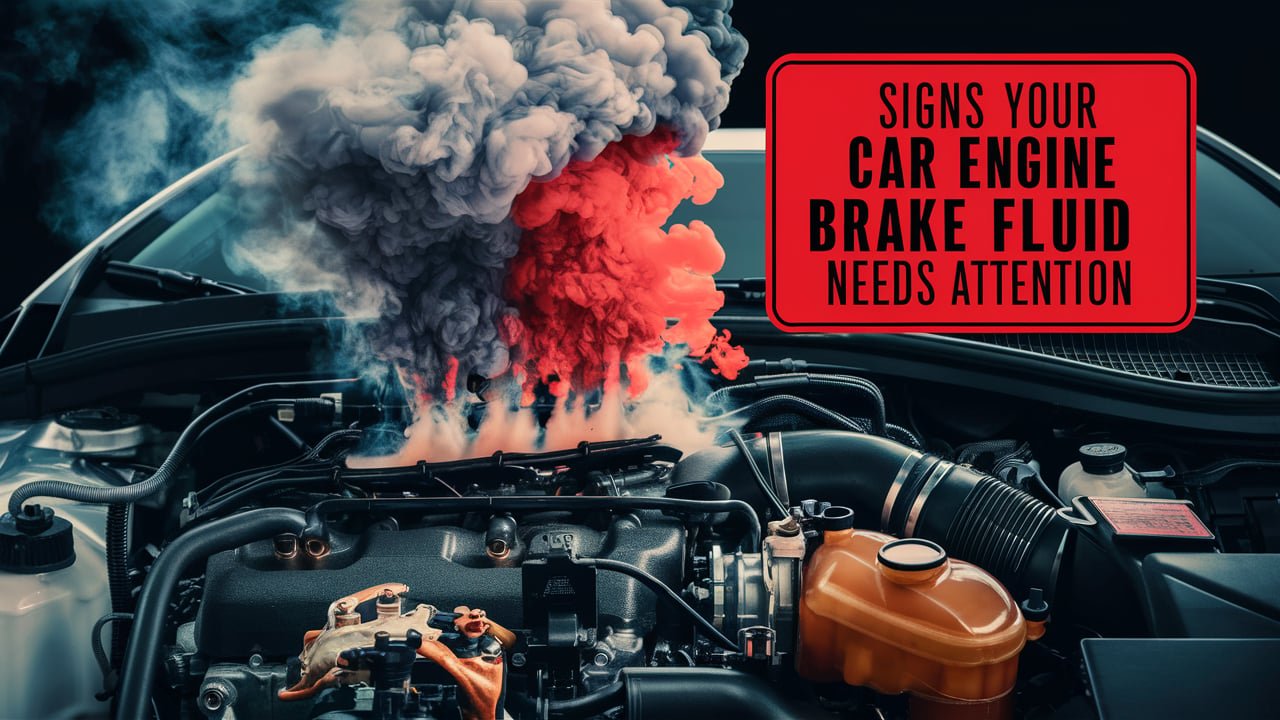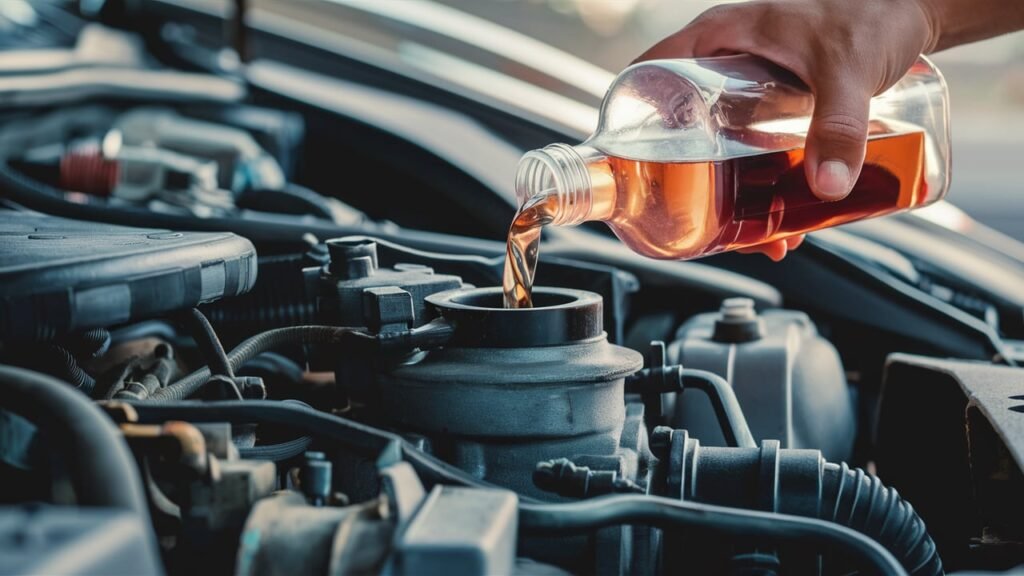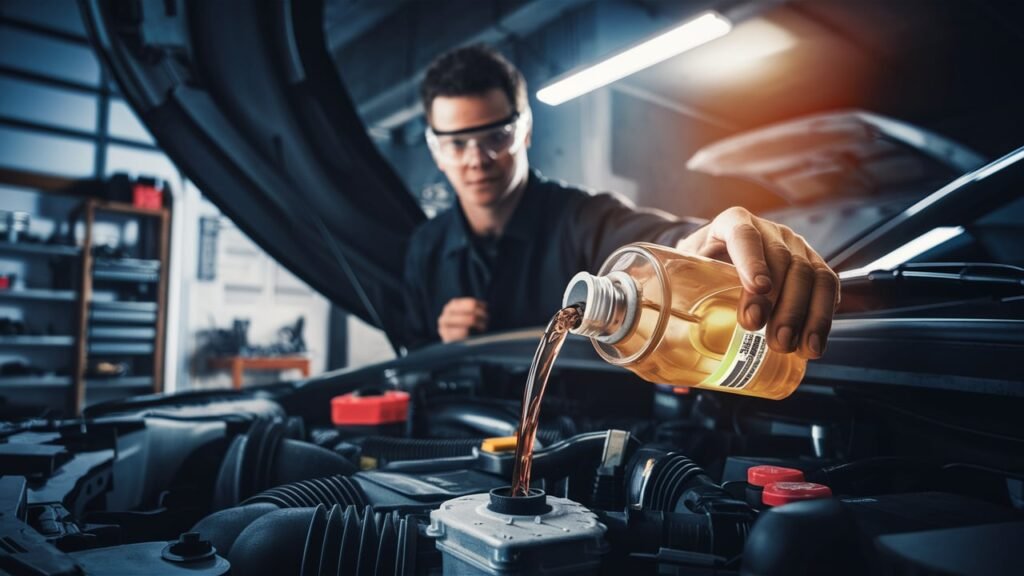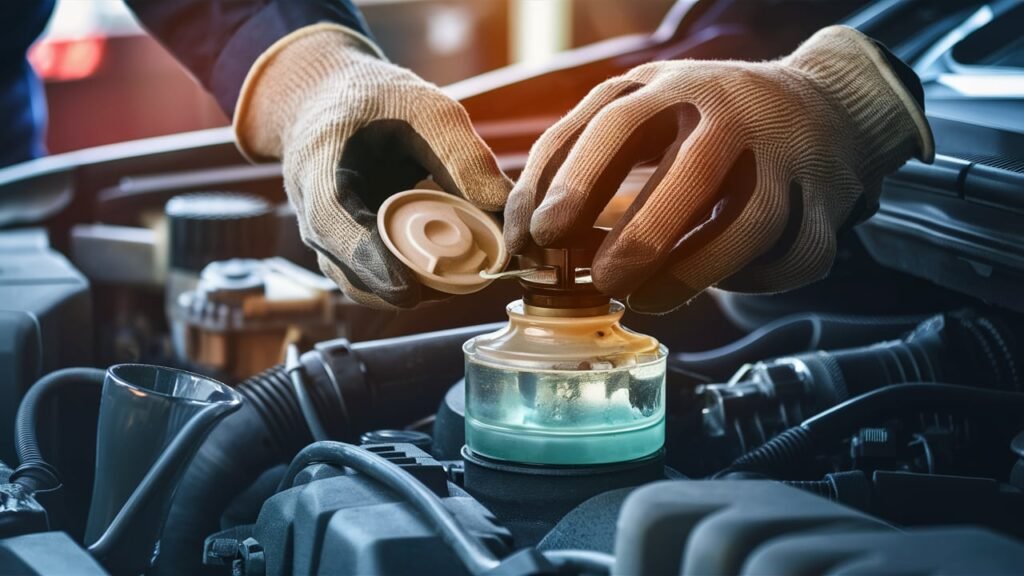
Signs Your Car Engine Brake Fluid Needs Attention
In the intricate symphony of your car’s engine, few components play as crucial a role as brake fluid. This often overlooked yet vital fluid acts as the silent conductor behind every safe stop and confident maneuver your vehicle makes.
Just like a finely tuned instrument requires precision to produce harmonious melodies, your car’s braking system relies on properly maintained brake fluid to function optimally.
Understanding the significance of this transparent liquid is not merely an exercise in technicality but a cornerstone of vehicular safety and performance.
As you navigate the labyrinthine roads of automotive maintenance, being attuned to the subtle whispers emanating from your car can prevent major crescendos of dysfunction down the line.
Signs that your car’s engine brake fluid needs attention are not mere trivialities; they are beacons cautioning against potential hazards looming beneath the surface.
From enigmatic dashboard warnings to peculiar odors seeping into your driving experience, these signs offer valuable insights into the inner workings of your vehicle’s braking infrastructure.
Delve with us into this comprehensive guide as we unveil seven telltale indicators that should prompt any conscientious driver, technician, or enthusiast to take heed and address their brake fluid concerns promptly.
Understanding Brake Fluid Basics.
Brake fluid is a hydraulic fluid specifically formulated to operate under high pressure and temperature conditions within a car’s braking system. It serves a crucial role in ensuring that your vehicle can safely slow down or come to a stop when needed.
When you press the brake pedal, the force is transmitted from the master cylinder through the brake lines filled with brake fluid to each wheel’s brake caliper or drum. This transmission of force amplifies your foot’s pressure, allowing for effective braking.
Using the correct type of brake fluid tailored for your vehicle is paramount due to differences in formulations intended for various braking systems. For example, some vehicles utilize traditional glycol-based fluids, while others employ silicon-based fluids.

Mixing different types can lead to reduced braking performance or even damage to components like seals and hoses within the braking system. Therefore, always consult your vehicle’s manual or seek professional advice to determine the appropriate brake fluid type for optimal functionality.
Understanding how brake fluid functions and choosing the right one for your car not only ensures efficient braking but also contributes to overall road safety.
In essence, maintaining an adequate level of quality brake fluid that matches your vehicle’s requirements guarantees that your brakes respond effectively in critical situations, providing you with peace of mind while driving on the road.
Sign 1: Low Brake Fluid Warning Light Illuminated.
When the low brake fluid warning light on your car’s dashboard illuminates, it serves as a crucial alert signaling a potential issue in your vehicle’s braking system. This indicator typically resembles an exclamation mark within a circle enclosed in parentheses and is designed to catch your attention promptly.
As part of the car’s onboard diagnostics system, this light monitors the brake fluid level in the reservoir. If the fluid drops below the recommended minimum level, often due to leaks or natural wear over time, this light activates to prompt you to address the situation urgently.
Taking immediate action when confronted with the low brake fluid warning light is paramount for ensuring your safety on the road. Neglecting this warning can lead to decreased braking efficiency, potentially resulting in longer stopping distances or even complete brake failure in extreme cases.
When faced with this signal, it is advisable not to ignore it or delay inspection and topping up of brake fluid levels. Promptly addressing low brake fluid helps maintain optimal braking performance and contributes significantly to overall driving safety.
For instance, imagine cruising down a highway when suddenly confronted by unexpected road hazards requiring rapid deceleration. If your brakes are compromised due to low brake fluid levels, your response time may be delayed, increasing the risk of collisions or accidents.
Therefore, staying attentive to warning lights like the low brake fluid indicator enables proactive maintenance that safeguards not only your vehicle but also yourself and other road users from potentially hazardous situations.
Sign 2: Soft or Spongy Brake Pedal Feel.
When the brake pedal in your car feels soft or spongy, it could be a sign of air bubbles present in the brake lines due to low brake fluid levels. Brake fluid plays a crucial role in transmitting the force generated when you press the brake pedal to actuate the braking system.
If there isn’t enough fluid to maintain pressure within the system, air can enter the lines and cause the pedal to feel less responsive or mushy. This compromised braking efficiency can significantly impact your ability to stop quickly and safely when needed.
Driving with a soft or spongy brake pedal is risky as it affects your vehicle’s braking performance. In emergency situations where sudden stops are required, having a compromised braking system can lead to longer stopping distances and potentially dangerous situations.

Properly functioning brakes are essential for road safety, and any indication of a decrease in braking effectiveness should prompt immediate attention to prevent accidents.
For instance, imagine approaching a traffic light that changes abruptly while driving with a spongy brake pedal. The delayed response from your brakes due to inadequate fluid levels could result in an increased risk of rear-end collisions or being unable to stop in time before entering an intersection.
This scenario underscores the importance of promptly addressing any issues related to soft or spongy brake pedals by checking and replenishing brake fluid levels as needed.
Sign 3: Leaking Brake Fluid Under the Car.
When you spot puddles or streaks of fluid under your car, it could be a telltale sign of leaking brake fluid. Identifying visible leakage is crucial as it directly affects the effectiveness of your braking system.
One common cause of brake fluid leaks is deteriorated brake lines or fittings that allow fluid to escape the closed system. Additionally, worn-out seals in components such as calipers or wheel cylinders can also lead to leaks.
These leaks not only compromise your ability to stop efficiently but can also pose serious safety risks if left unattended.
Leaking brake fluid can have severe implications on vehicle safety. The loss of brake fluid means there is less hydraulic pressure available for the brakes to function optimally, potentially resulting in longer stopping distances or even complete brake failure.
If left unresolved, this could lead to hazardous situations on the road, endangering both the driver and others sharing the road. It’s essential to address any signs of brake fluid leaks promptly by consulting a qualified technician to inspect and repair the damaged components.
In some cases, identifying the source of a brake fluid leak may require professional expertise due to the intricate nature of modern braking systems.
Although finding and fixing these leaks might seem daunting at first glance, timely intervention can prevent more extensive damage and ensure that your vehicle remains safe to drive.
Regular inspections can help catch these issues early, allowing for preventive maintenance that safeguards not only your braking performance but also your overall driving experience.
Remember, addressing leaking brake fluid isn’t just about maintaining your car; it’s about safeguarding lives on the road by ensuring optimal braking efficiency at all times.
Sign 4: Discolored Brake Fluid.
Discolored brake fluid is often a clear sign that the fluid has become contaminated or degraded, compromising its effectiveness in your car’s braking system. This discoloration can range from a light haze to dark brown or even black, depending on the extent of contamination.
Contaminants like moisture, dirt, and debris can seep into the brake fluid over time, leading to discoloration. Additionally, heat and oxidation can accelerate this process, further deteriorating the quality of the brake fluid.
Using deteriorated brake fluid can have significant consequences on your braking performance. Contaminants in the fluid can cause corrosion within the braking system components, leading to potential damage and reduced efficiency.

Furthermore, compromised brake fluid may result in issues such as decreased hydraulic pressure within the system, affecting your ability to stop quickly and safely. In extreme cases, severely degraded brake fluid can even lead to total brake failure, putting you at great risk while driving.
To ensure optimal performance and safety on the road, it is crucial to address any instances of discolored brake fluid promptly. Ignoring this sign not only jeopardizes your vehicle’s braking capabilities but also endangers you and others on the road.
Regularly checking the color and condition of your brake fluid as part of your maintenance routine can help you detect issues early on and prevent more severe complications down the line. Remember that clear, clean brake fluid is essential for maintaining effective braking function in your vehicle.
Sign 5: Unusual Noises When Braking.
When braking, your car should operate smoothly and quietly. However, if you start hearing unusual noises like squealing, grinding, or clicking sounds, it could be a sign that your brake fluid needs attention.
These noises may occur due to air bubbles in the brake lines caused by low levels of brake fluid or contamination from foreign particles. Ignoring these noises may lead to further damage to your braking system and compromise your safety on the road.
Squealing noises when applying the brakes often indicate worn-out brake pads or shoes but can also point towards issues with the brake fluid. Grinding sounds can signify metal-on-metal contact within the braking system, which can happen when there’s insufficient lubrication from degraded brake fluid.
Clicking noises might suggest uneven wear on the brake components due to inconsistent hydraulic pressure caused by improper levels of brake fluid.
If these unusual noises persist but are overlooked, the risks can escalate quickly. Continued driving with compromised brake fluid can result in decreased braking efficiency and even complete failure of the brakes.
Such scenarios could lead to accidents, endangering not only yourself but also other road users. Therefore, it is crucial to address these auditory warning signs promptly by inspecting and possibly flushing out your brake fluid for optimal performance and safety on the road.
Sign 6: Increased Stopping Distance.
When you notice an increased stopping distance in your car, it may be an indication that your brake fluid needs attention. Brake fluid plays a crucial role in transferring the force from your foot on the brake pedal to the actual braking mechanism of the vehicle.
If there is a decrease in the efficiency of this hydraulic system due to low levels or degraded quality of brake fluid, it can result in a delayed response when you apply the brakes.
Imagine needing to stop suddenly to avoid a collision but experiencing a lag in your vehicle’s ability to respond promptly – this delay could have serious consequences.
The connection between reduced braking efficiency and brake fluid levels is direct and critical for safe driving. As brake fluid deteriorates or decreases in quantity, it hampers the consistent transmission of pressure to the brakes, causing them to respond sluggishly.
This issue can lead to accidents or near-misses on the road, especially during emergency situations where swift braking is essential. Therefore, any noticeable increase in stopping distance should serve as a red flag prompting immediate inspection and maintenance of your car’s brake system.
In essence, when your car exhibits an extended stopping distance compared to what you are accustomed to, it’s essential not to ignore this warning sign. The safety implications of compromised braking performance are significant and should be addressed promptly by checking the brake system thoroughly.
By ensuring that your brake fluid levels are adequate and that the fluid is at its optimal condition, you contribute to safer driving experiences for both yourself and others on the road.
Remember, maintaining proper brake function through regular inspections and timely maintenance can prevent potential accidents caused by inadequate braking capabilities.
Sign 7: Burning Smell While Driving.
A burning smell while driving can be a concerning sign that your car’s brake fluid needs attention. This odor is often associated with overheated or contaminated brake fluid.
Overheating can occur when the braking system is being overworked due to factors like towing heavy loads, continuous hard braking, or driving in hilly terrains that strain the brakes excessively.
Contamination of the brake fluid might happen due to moisture intrusion or debris buildup over time. These issues can lead to reduced braking efficiency and potentially compromise your safety on the road.
Ignoring the burning smell while driving could have serious safety implications. If left unchecked, overheated or contaminated brake fluids can result in brake fade, where the brakes lose their effectiveness due to excessive heat buildup.
This can significantly increase stopping distances, putting you at a higher risk of accidents, especially in emergency braking situations. Additionally, contaminated brake fluid may contain particles that could damage crucial components within the braking system over time, leading to costly repairs if not addressed promptly.
When encountering a burning smell while driving, it is crucial to address this issue immediately and have your vehicle inspected by a qualified mechanic. Taking prompt action can help prevent further deterioration of the braking system and ensure optimal safety while driving.
Regular maintenance checks and timely replacement of brake fluid based on manufacturer recommendations can help avoid potential risks associated with overheated or contaminated brake fluids, allowing for consistent and reliable braking performance on the road.
Conclusion and Maintenance Recommendations.
In summary, the signs indicating that your car’s engine brake fluid needs attention are crucial indicators of potential safety hazards.
Regular inspection and maintenance of brake fluid play a vital role in ensuring the optimal performance of your vehicle’s braking system. To maintain safety and functionality, here are some key maintenance tips to consider:
– **Regular Inspection:** Schedule routine checks of your brake fluid level, color, and quality as part of your vehicle maintenance routine.
– **Use Recommended Brake Fluid:** Ensure you use the manufacturer-recommended brake fluid type suitable for your specific vehicle model.
– **Address Issues Promptly:** If any of the warning signs mentioned earlier manifest, promptly address them to prevent further complications or safety risks.
– **Consider Professional Assistance:** When in doubt about handling brake fluid issues, seek help from qualified automotive technicians to accurately diagnose and resolve any problems.
By adhering to these maintenance tips and remaining vigilant for the signs discussed in this article, you can proactively safeguard yourself and others on the road. Remember, maintaining healthy brake fluid is not just about operational efficiency but also about prioritizing safety in every drive.




